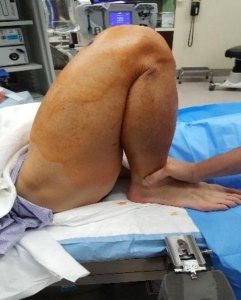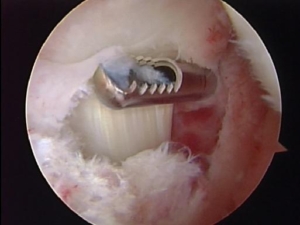What is Arthrofibrosis of the Knee?
The knee is a complex modified hinge joint that consists of 4 bones, multiple ligaments, muscles and tendons, cartilage and soft tissue. Its primary motions are of flexion and extension. However, when these structures are subjected to trauma or injury, complications can occur. Arthrofibrosis is a complication of the knee that occurs when the joint becomes stiff losing pain-free range of motion. In the event that this condition occurs, excessive scar tissue forms within the joint and soft tissue structures. This condition can occur in anyone in any age category following trauma or major surgical knee procedures.

Symptoms
Symptoms begin gradually and worsen as the knee is moved less and less due to pain following a trauma, complication of poor joint mobilization with physical therapy or non-compliance with a home exercise program following surgical management. By utilizing the knee less, adhesions form within the joint and soft tissue. These adhesions tighten the knee causing decreased range of motion and increased pain. This is the first stage of the condition called the freezing stage. The second stage or frozen stage takes place when pain can become severe, significant range of motion is lost, nighttime pain and the inability to move the knee through the full range of motion. The final stage or thawing period occurs when pain decreases and range of motion improves to normal. However, if this condition is not recognized or treated, permanent complications can occur.
Diagnosis
Diagnosis will be determined through a thorough history and physical examination by a trained sports medicine and orthopedic shoulder specialist. During the office examination, your knee will be moved in all directions to determine what range of motion has been lost. Typically passive and active range of motion has been lost and can be significant at times. Additional manual testing by the specialist will assist in determining the stage of the condition. If symptoms are a result of non-surgical and non-traumatic X-rays and MRI’s may be ordered to determine pathology causing symptoms.
Treatments
Treatments can include conservative versus surgical management. A specific individualized treatment program will be created from your thorough history, physical examination, and radiological testing. More than 95% of patients with early onset arthrofibrosis will resolve the condition with conservative management. This includes aggressive range of motion work through physical therapy, home program and occasionally with the use of orthopedic movement devices. Additional treatments utilized include anti-inflammatory medications, cortisone injection and therapeutic modalities. If the range of motion is not progressing conservatively a closed knee manipulation could be recommended. This is an outpatient procedure that requires the physician to manipulate the knee to its full range extension and flexion why under anesthetic sedation. The procedure is outpatient and takes less than 5 minutes. See photos below.

Closed Knee Manipulation – Flexion

Closed knee Manipulation – Extension
If the lost motion is a result of a surgical procedure, arthroscopic debridement would be recommended vs closed manipulation to avoid reinjury to the originally repaired knee structures. Under anesthesia, the physician arthroscopically removes or debrides the scar tissue. Once the knee is rid of the scar tissue within the joint, the physician manipulates the knee to full extension and flexion. This is also an outpatient procedure. Below, the arthroscopic picture shows scar within the knee joint being removed.

Arthroscopic Scar Tissue Removal
Rehabilitation
Rehabilitation for both is required and very aggressive to maintain full functional range of motion. Daily therapy is required for the first week followed by two to three times per week until motion, strength, and stability equalize to the non-affected side. Recovery varies significantly depending on the initial injury, surgical procedure and treatment rendered.
